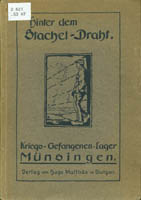Table of Contents
Appendix 3a
Hinter dem Stachel-Draht:
Kriegs-Gefangen-Lager Münsingen
(Behind the Barbed-Wire: Prisoner of War Camp Münsingen)
 This 1918 publication provides a general overview of life in the prison camp in Münsingen in Württemberg. This book is interesting
because it focuses on the activities within a single prison camp instead of a montage of photographs and summaries from a wide range of
POW facilities which characterized German POW literature in 1915 and 1916. The first French prisoners arrived in Münsingen on 22 August
1914, and lived in tents until barracks and prison compound were constructed. Russian POW's followed in November 1914, and they were
succeeded by Serbian and Italian prisoners as the war progressed. The camp was modest in scale, in relation to the massive German prison
camps in Münster and Sennelager, with a capacity of around four thousand prisoners. The camp came under the supervision of the commander of the
XIII Corps (Royal Württemberg Army Corps), headquartered in Stuttgart.1
This 1918 publication provides a general overview of life in the prison camp in Münsingen in Württemberg. This book is interesting
because it focuses on the activities within a single prison camp instead of a montage of photographs and summaries from a wide range of
POW facilities which characterized German POW literature in 1915 and 1916. The first French prisoners arrived in Münsingen on 22 August
1914, and lived in tents until barracks and prison compound were constructed. Russian POW's followed in November 1914, and they were
succeeded by Serbian and Italian prisoners as the war progressed. The camp was modest in scale, in relation to the massive German prison
camps in Münster and Sennelager, with a capacity of around four thousand prisoners. The camp came under the supervision of the commander of the
XIII Corps (Royal Württemberg Army Corps), headquartered in Stuttgart.1
 The eighty-eight-page book documents POW daily life, addressing issues such as a historical overview of the facility, correspondence between
prisoners and family and friends, quotations from prisoner diaries, spiritual life in the camp, education, holidays, neutral inspection
and welfare visits, the plight of Serbian prisoners, health and welfare, nutrition, occupations and handicrafts, agricultural work,
escape attempts, and funeral arrangements. The narrative describes in detail the lesson plans available to French and Russian prisoners,
efforts to combat disease and promote hygiene, daily food allotments and dietary standards, the holdings of foreign language libraries
available to POW's, and a wide range of information regarding life in the prison. Of note, the book addresses the work of YMCA War
Prisoners' Aid secretaries, Crawford Wheeler (United States) and Emil Diehl (Sweden) on page 53. The secretaries provided prisoners with
books, plays, musical instruments, music, and, perhaps most importantly, conversation in their efforts to improve the spiritual and
social conditions in the camp. As indicated in the text, Diehl replaced Wheeler as the secretary responsible for POW camps in Württemberg
after the United States broke off diplomatic relations with Germany in February 1917.
The eighty-eight-page book documents POW daily life, addressing issues such as a historical overview of the facility, correspondence between
prisoners and family and friends, quotations from prisoner diaries, spiritual life in the camp, education, holidays, neutral inspection
and welfare visits, the plight of Serbian prisoners, health and welfare, nutrition, occupations and handicrafts, agricultural work,
escape attempts, and funeral arrangements. The narrative describes in detail the lesson plans available to French and Russian prisoners,
efforts to combat disease and promote hygiene, daily food allotments and dietary standards, the holdings of foreign language libraries
available to POW's, and a wide range of information regarding life in the prison. Of note, the book addresses the work of YMCA War
Prisoners' Aid secretaries, Crawford Wheeler (United States) and Emil Diehl (Sweden) on page 53. The secretaries provided prisoners with
books, plays, musical instruments, music, and, perhaps most importantly, conversation in their efforts to improve the spiritual and
social conditions in the camp. As indicated in the text, Diehl replaced Wheeler as the secretary responsible for POW camps in Württemberg
after the United States broke off diplomatic relations with Germany in February 1917.
The purpose of this book was to inform both the German public and Allied readers of the humane conditions which existed in Münsingen during the war. The book has propaganda value in terms of offering an alternate view of the atrocities Allied authorities claimed regarding German prison camp conditions. The authors described the development of the prison camp and how the authorities had progressed in terms of the health, welfare, and labor conditions for Allied prisoners. The book was published in early 1918, in Stuttgart and the quality of the book reflects wartime conditions in the German empire. While the book features a color plate painting of the camp and a black and white plate drawing of the prison cemetery, the quality of the paper is poor, a reflection of wartime paper scarcity. There are fifty-nine pictures in the narrative, but most are wood block cuts and drawings, with few photographs. The quality of materials used in the book are clearly deficient in comparison to German publications from 1915 and early 1916.
Notes:
Note 1: Hinter dem Stachel-Draht: Kriegs-Gefangen-Lager Muensingen. Stuttgart, Wuerttemberg: Hugo Matthias, 1918. back